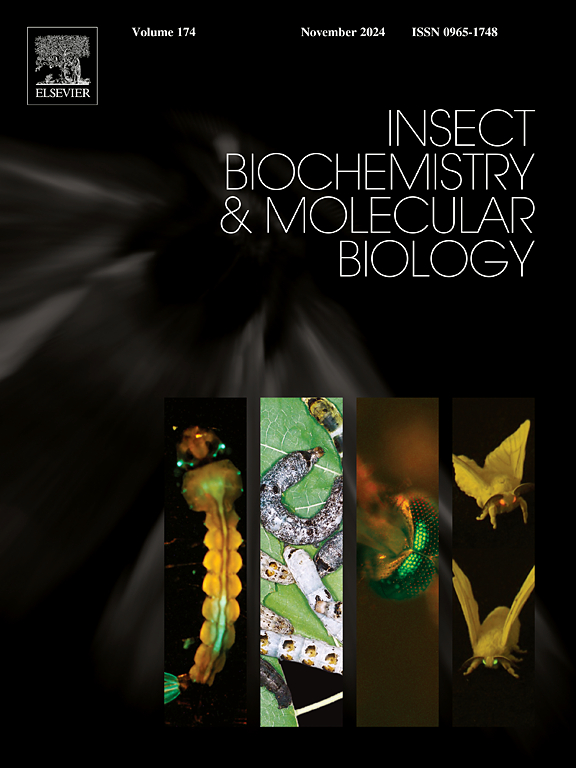果蝇可以告诉我们昆虫中依赖状态的肽能信号。
IF 3.7
2区 农林科学
Q2 BIOCHEMISTRY & MOLECULAR BIOLOGY
引用次数: 0
摘要
动物行为和生理的可塑性很大程度上是由于神经肽和肽激素(统称为NPHs)的调节和调节信号。nph构成了一个非常大的、多用途的信号物质组,它们在生物体的大多数日常活动中以不同的调节水平参与。本文综述了NPH在大脑和器官间信号传导中的作用的关键原理,并以果蝇为重点。nph由神经元、神经分泌细胞(NSCs)和其他内分泌细胞以nph特异性和刻板模式产生。大多数nph具有多种(多效性)功能,并针对几种不同的神经回路和/或外周组织。这种不同的NPH信号确保了行为和生理以状态依赖的方式协调。相反,许多神经元、电路、NSCs或其他细胞被多个nph靶向。这种收敛信号通常向中枢神经元/电路传递各种报告外部和内部环境变化的信号。作为更广泛的功能趋同的一个例子,26种不同的果蝇nph在许多不同的水平上调节食物寻找和喂养。外周功能的激素调节也有趋同现象。例如,多个NPHs靶向肾小管以确保渗透稳态。有趣的是,一些相同的渗透调节nph也调节摄食、代谢和应激。然而,对于一些NPHs,细胞分布和功能表明多个不相关的功能被限制在特定的电路中。因此,NPH信号在每个特定的NPH中遵循不同的模式,但将它们放在一起形成重叠的网络,调节行为和生理。本文章由计算机程序翻译,如有差异,请以英文原文为准。

What Drosophila can tell us about state-dependent peptidergic signaling in insects
Plasticity in animal behavior and physiology is largely due to modulatory and regulatory signaling with neuropeptides and peptide hormones (collectively abbreviated NPHs). The NPHs constitute a very large and versatile group of signaling substances that partake at different regulatory levels in most daily activities of an organism. This review summarizes key principles in NPH actions in the brain and in interorgan signaling, with focus on Drosophila. NPHs are produced by neurons, neurosecretory cells (NSCs) and other endocrine cells in NPH-specific and stereotypic patterns. Most of the NPHs have multiple (pleiotropic) functions and target several different neuronal circuits and/or peripheral tissues. Such divergent NPH signaling ensures orchestration of behavior and physiology in state-dependent manners. Conversely, many neurons, circuits, NSCs, or other cells, are targeted by multiple NPHs. This convergent signaling commonly conveys various signals reporting changes in the external and internal environment to central neurons/circuits. As an example of wider functional convergence, 26 different Drosophila NPHs act at many different levels to regulate food search and feeding. Convergence is also seen in hormonal regulation of peripheral functions. For instance, multiple NPHs target renal tubules to ensure osmotic homeostasis. Interestingly, several of the same osmoregulatory NPHs also regulate feeding, metabolism and stress. However, for some NPHs the cellular distribution and functions suggests multiple unrelated functions that are restricted to specific circuits. Thus, NPH signaling follows distinct patterns for each specific NPH, but taken together they form overlapping networks that modulate behavior and physiology.
求助全文
通过发布文献求助,成功后即可免费获取论文全文。
去求助
来源期刊
CiteScore
7.40
自引率
5.30%
发文量
105
审稿时长
40 days
期刊介绍:
This international journal publishes original contributions and mini-reviews in the fields of insect biochemistry and insect molecular biology. Main areas of interest are neurochemistry, hormone and pheromone biochemistry, enzymes and metabolism, hormone action and gene regulation, gene characterization and structure, pharmacology, immunology and cell and tissue culture. Papers on the biochemistry and molecular biology of other groups of arthropods are published if of general interest to the readership. Technique papers will be considered for publication if they significantly advance the field of insect biochemistry and molecular biology in the opinion of the Editors and Editorial Board.

 求助内容:
求助内容: 应助结果提醒方式:
应助结果提醒方式:


